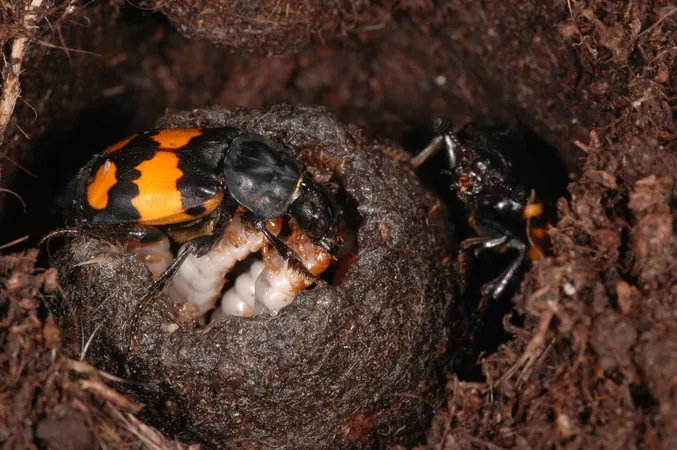
Breakthrough Study Reveals the Hidden Language of Burying Beetles and Its Impact on Their Young
2024-10-31
Author: Yu
Introduction
Researchers at the University of Bayreuth have made a groundbreaking discovery regarding the intricate communication of burying beetles, revealing that larvae suffer from lower weights and higher mortality rates when parental acoustic communication is compromised during brood care. This pioneering study is paving the way for a deeper understanding of animal communication.
Importance of Communication in Animal Behavior
Within the realm of animal behavior, communication is vital for cooperative actions such as parental care. Various species display different levels of social complexity, and the interactions within animal families can greatly influence the upbringing of their young. To analyze how communication impacts evolutionary family dynamics, the team turned to burying beetles—organisms with relatively simple social systems.
Research Publication and Significance
Published in the journal Animal Behaviour, this research not only sheds light on beetle communication but also enhances our comprehension of social behavior evolution among species. Proper recognition and interaction with mates and offspring are fundamental for survival, but the specific functions of distinct communication signals often remain elusive.
Previous Research and Innovative Approach
While prior studies have primarily focused on chemical signaling within insect family structures, Dr. Taina Conrad and her team at Bayreuth took the innovative step of investigating acoustic signals in burying beetles (Nicrophorus) during brood care, marking the first of its kind. Notably, these beetles display exceptional parental involvement; both parents care for their larvae by burying a small mammal carcass that serves as a nourishment source. After the larvae hatch, the parents nurture them while emitting unique chirping sounds known as stridulation—created by rubbing their wing cases against their abdomens.
Research Findings and Methodology
To explore this further, the researchers experimented by silencing the stridulatory apparatus of parent beetles using tape. This manipulation involved three species of Nicrophorus that vary in parental care dependence. The findings revealed that all species exhibited negative effects from the absence of communication, particularly in larval weight and survival rates. Interestingly, while the most dependent larvae were significantly impacted, the less dependent ones showed minimal detrimental effects, indicating the timing and context of communication are also crucial factors in brood care.
Conclusion and Future Directions
Our study is an essential first step in demonstrating that stridulation is vital during brood care in burying beetles. Future research aims to unravel the precise messages conveyed through these sounds and how this coordination enhances parental care. This study not only opens new avenues for exploring how communication influences the survival of young insects but also reflects broader implications for understanding social behaviors across the animal kingdom.
Final Thoughts
As more research is conducted in this area, we may soon gain a clearer picture of the dynamic interactions that shape the lives of these fascinating creatures. Stay tuned for more revelations from the hidden world of beetle communication!




 Brasil (PT)
Brasil (PT)
 Canada (EN)
Canada (EN)
 Chile (ES)
Chile (ES)
 España (ES)
España (ES)
 France (FR)
France (FR)
 Hong Kong (EN)
Hong Kong (EN)
 Italia (IT)
Italia (IT)
 日本 (JA)
日本 (JA)
 Magyarország (HU)
Magyarország (HU)
 Norge (NO)
Norge (NO)
 Polska (PL)
Polska (PL)
 Schweiz (DE)
Schweiz (DE)
 Singapore (EN)
Singapore (EN)
 Sverige (SV)
Sverige (SV)
 Suomi (FI)
Suomi (FI)
 Türkiye (TR)
Türkiye (TR)